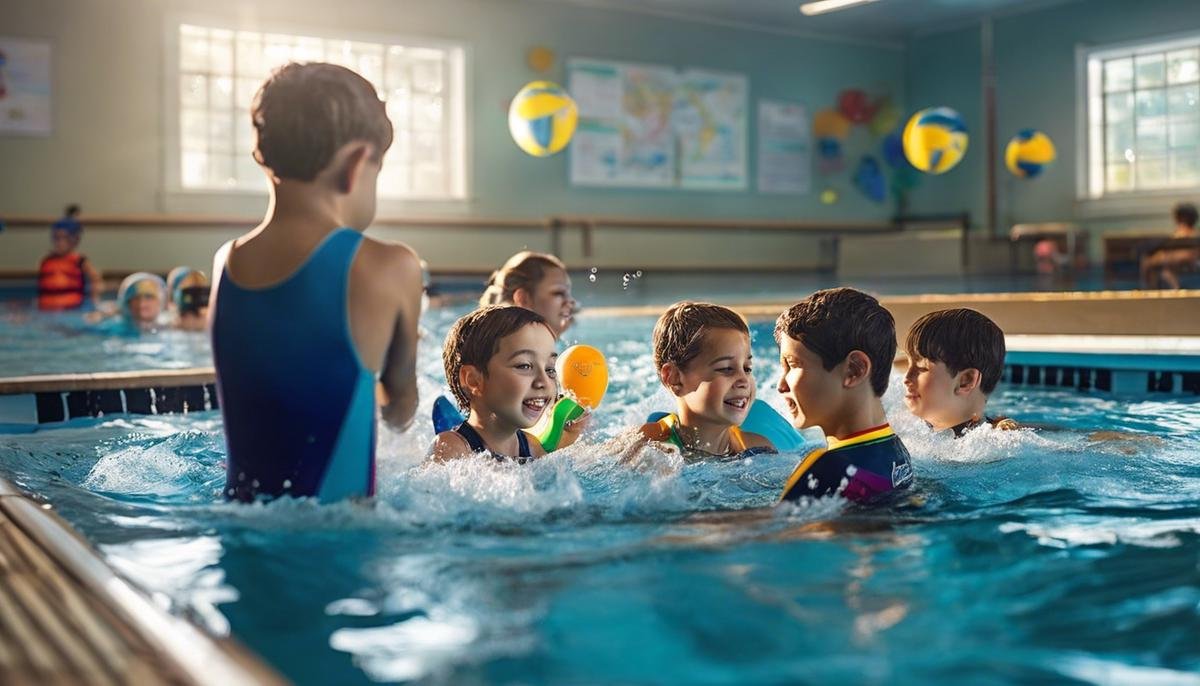
Imagine the sheer joy of a child splashing around in the water, webbed fingers creating countless bubbles that shimmer in the golden sun. Now imagine this child has autism, and this seemingly simple pastime represents a victory over sensory sensitivities and communication hurdles. Autism, often characterized by unique responses to sensory experiences and distinctive communication patterns, can present special challenges when it comes to activities involving groups or water. However, with a better understanding of these challenges and adaptive strategies that cater to their needs, swimming can become an enjoyable and therapeutic experience for autistic children. This involves smart modifications to regular swimming lessons, and ensuring a safe, calm, and clutter-free pool environment that comprehensively supports their comfort and learning.
Understanding Autism
“Understanding the Core Challenges Autistic Children Encounter during Physical Activities, such as Swimming”
As fellow parents and caregivers, today, we’re stepping into the world of physical activities for kids with autism, focusing primarily on swimming. This journey isn’t an attempt to paint a distressing picture but to deepen our understanding of the unique challenges such children may encounter. With this understanding, we can then create an inclusive and supportive environment for them.
Autism Spectrum Disorder (ASD) is characterized by a wide range of physical, social, and cognitive difficulties. These challenges can be amplified during physical activities such as swimming, a skill whose mastery deeply revolves around communication, coordination, and sensory integration.
Firstly, let’s delve into the realm of Sensory Overload. Children with ASD often deal with heightened sensitivities to their environments. The splash of water, the echo in a swimming pool, or even the texture of a swimsuit can be overwhelming. This sensory overload can create anxiety, making it difficult for these children to participate, let alone enjoy these activities.
Next, let’s touch upon motor planning and coordination – vital aspects for mastering any physical activity, including swimming. Kids with autism might struggle with the complex, sequential tasks involved in swimming due to challenges in fine and gross motor skills, making it hard to grasp the technicalities of this activity.
Another challenge worth noting is difficulty with social interaction. For many neurotypical children, recreation is about fun and socialization. However, children with ASD often find it challenging to interpret social cues or engage in cooperative play. Hence, group swimming lessons might pose as a struggle for these children.
Finally, let’s discuss communication challenges that are synonymous with ASD. Swimming coaches regularly rely on verbal instructions, which for a child on the spectrum, might be hard to understand or follow. This increases the risk of misunderstanding or miscommunication.
Having understood these challenges, the critical question then arises – “What can we do about it?” It’s all about helping these children to navigate physical activities in the most comfortable way possible. Smaller groups or one-on-one classes, clear visual aids in instruction, time for acclimatization, and the use of appropriate sensory items such as swimming earplugs can make a world of difference.
Remember, every child with autism is unique, and these challenges will not apply universally. Yet having a deeper understanding of the core difficulties faced during physical activities can enable us to provide a more enriching and inclusive environment for children with ASD. Swimming might be a challenge, but with the right approach, it can turn into an enjoyable activity that boosts confidence and strengthens bodies and minds.

Adapting Swimming Lessons
Paving Waves: Making Swimming Lessons a Joyful Experience for Autistic Kids
Diving deeper into our topic of making subjective the aquatic experience of kids living with Autism Spectrum Disorder (ASD), it becomes paramount to veer our focus toward further adaptive measures. It’s about more than just overcoming basic challenges – it’s about crafting an enjoyable, rewarding experience for these unique little individuals. With ingenuity and empathy, there are numerous ways we can shape these classes to not only lessen stress but also cultivate joy.
Children on the autism spectrum commonly exhibit unique learning styles. One key adaptation is employing hands-on learning techniques to substitute, or supplement traditional verbal instructions. This might take the form of a physical demonstration, using a doll or action figure, or even gently guiding the child’s body through the desired motion. Remember, for some kids, seeing and feeling can be more instructive than hearing.
Another beneficial technique is the incorporation of assistive toys and tools. “Pool noodles” and kickboards serve a dual purpose: they add a dash of fun and whimsy to the classes while also providing essential support for children who may struggle with floatation and balance. A bit of assistance can make a world of difference for a child who’s still grasping at the ropes of flexibility and body control.
Repetition is another valuable component in adapting swimming lessons. Repetitive practice instills confidence, bolsters memory, and helps to structure the swimming environment in predictable ways that suit the preference of many children with ASD. From practicing simple legs kicks to more complex swimming strokes, ensure to consistently maintain this structure within each lesson.
Swimming games can also be a powerful ally in engaging autistic children. The introduction of playful elements maintains their interest and sustains motivation, making the lessons feel less like instruction and more like fun. Games like “Fish in the Pond” or “Treasure Hunt,” complete with prizes, biodegradable confetti or even just enthusiastic cheers can transform lessons into a joyful aquatic playground.
In the context of group lessons, pair each child with a “swim buddy.” This method of peer pairing results in not only improved group interaction but also enhances emotional comfort and support. It promotes bonding, social understanding, and a sense of achievement that comes with teamwork.
A final piece of advice is open communication. Foster continuous dialogue with parents, as they can offer insight into their child’s personal comfort level, preferences, or specific triggers. This intimate knowledge of the child can help in designing a tailor-made lesson plan, ensuring a more enjoyable and less stressful experience.
By integrating these adjustments into swimming lessons, we’re not just guiding children with ASD through the waters – we’re also creating a positive environment where their unique skills can flourish. It’s about building strength and confidence alongside a strong swimming prowess. It isn’t just about surviving the tide; it’s about teaching them to enjoy the ride.

Creating a Safe Environment
Creating a Safe and Welcoming Pool Environment for Children with Autism
Ensuring that a child with autism feels safe and supported starts with creating the right environment. It’s crucial to foster an atmosphere that generically caters to the requirements that come with Autism Spectrum Disorder (ASD). Since you’ve got much of the basics – sensory, social, and communication aspects – let’s dive a little deeper into creating a comforting environment in the pool for your child with autism.
One effective strategy is to create a quiet corner at the pool. This section acts as a safe haven for your child and can help deal with sensory overload or anxiety. Have a favorite toy, comfortable towel, or calming sensory items close at hand. This gives your child a place to retreat and decompress, ensuring they can return to swimming when they feel ready.
Consider implementing visual schedules as well. It’s beneficial for children with autism to know what to expect. A visual schedule can help your child understand the swimming routine–from changing into swimwear, to pooltime, and finally changing back into their regular clothes. Posting this schedule can provide much-needed structure around the pool.
Bringing comfort items to the pool can also offer extra support. Similar to the quiet corner, comfort items can help battle sensory overload and create a sense of security. It could be anything from a favored swimwear, a special towel, or a preferred pool float.
The use of swimwear designed for sensory sensitiveness is also a great idea. Swim gear that fits snugly can offer a sense of security, acting like a calming pressure. There’s also swimwear available with seamless design and soft fabric to ensure nothing rubs or irritates the skin.
It’s also essential to keep communication lines wide open. Parents, always keep swimming instructors in the loop about the ways your child learns best and any possible triggers. That way, they could adapt their approach to match your child’s needs.
And lastly, let’s not forget the power of celebration and encouragement. Recognize and praise progress, no matter how small. This can help boost motivation, reinforce positive behavior, and make swimming a more enjoyable experience for your child.
Remember, each child with autism is unique with their own strengths, likes, and difficulties. What works for one may not work for the other. It’s all about experimenting, observing, and adapting. With patience, understanding, and the right approach, your child can learn to love their time in the pool just as much as others do. Happy swimming!

The key to making swimming a delightful experience for autistic children lies in a balanced blend of understanding, adaptation, and safety assurance. When we gain a strong understanding of autism and acknowledge the individual sensory sensitivities and communication challenges that these children may face, we can adapt swimming lessons to better suit their needs. Clear instructions, visual aids, self-paced learning, sensory-stimulating aquatic games, and social interaction opportunities become the tools that transform a potentially daunting activity into a fun and inclusive adventure. Paired with a safe, serene, and organized pool environment, these vibrant experiences foster a long-lasting love for swimming in autistic children, granting them not just a valuable skill but a source of joy and accomplishment.




